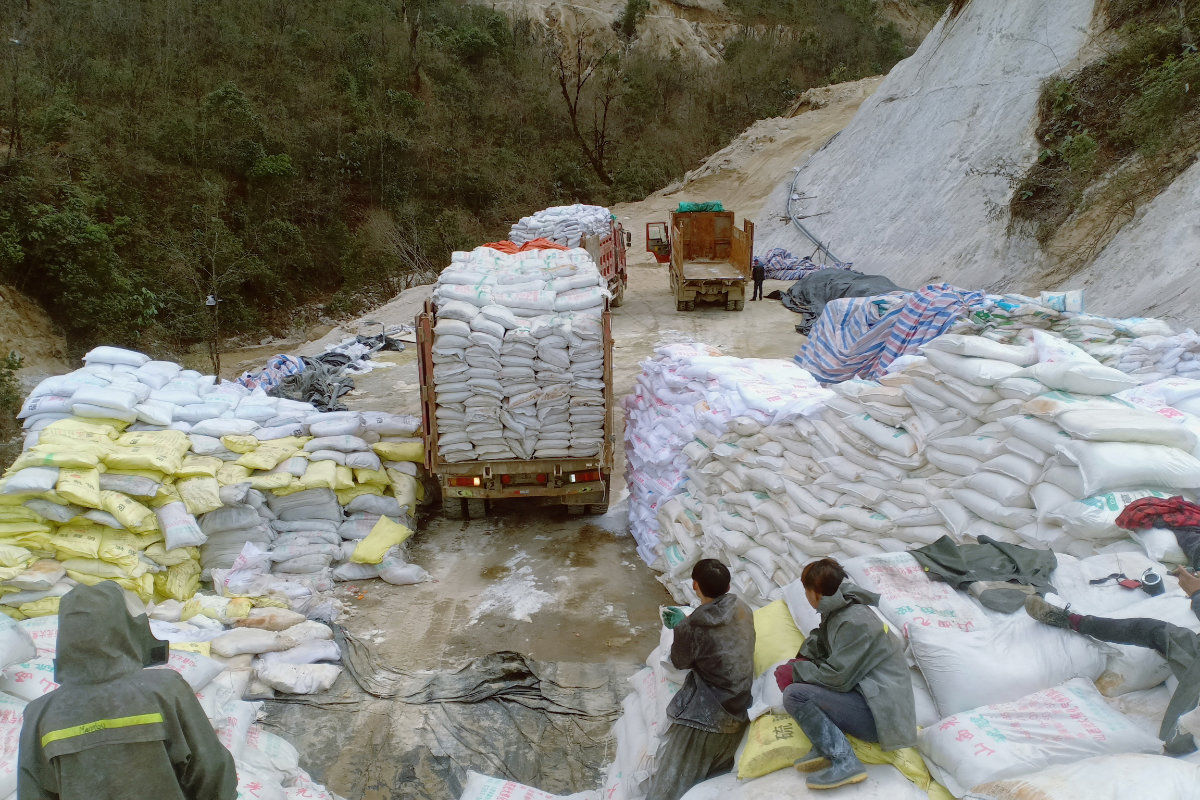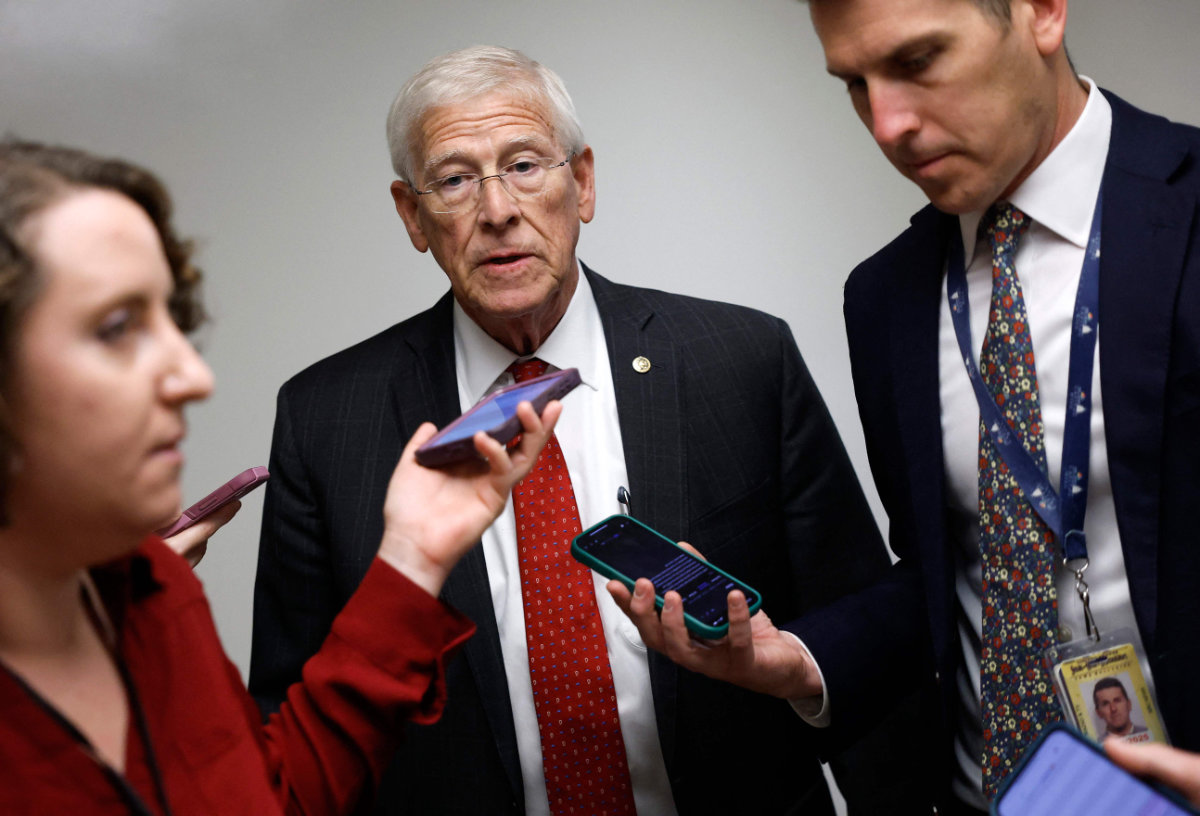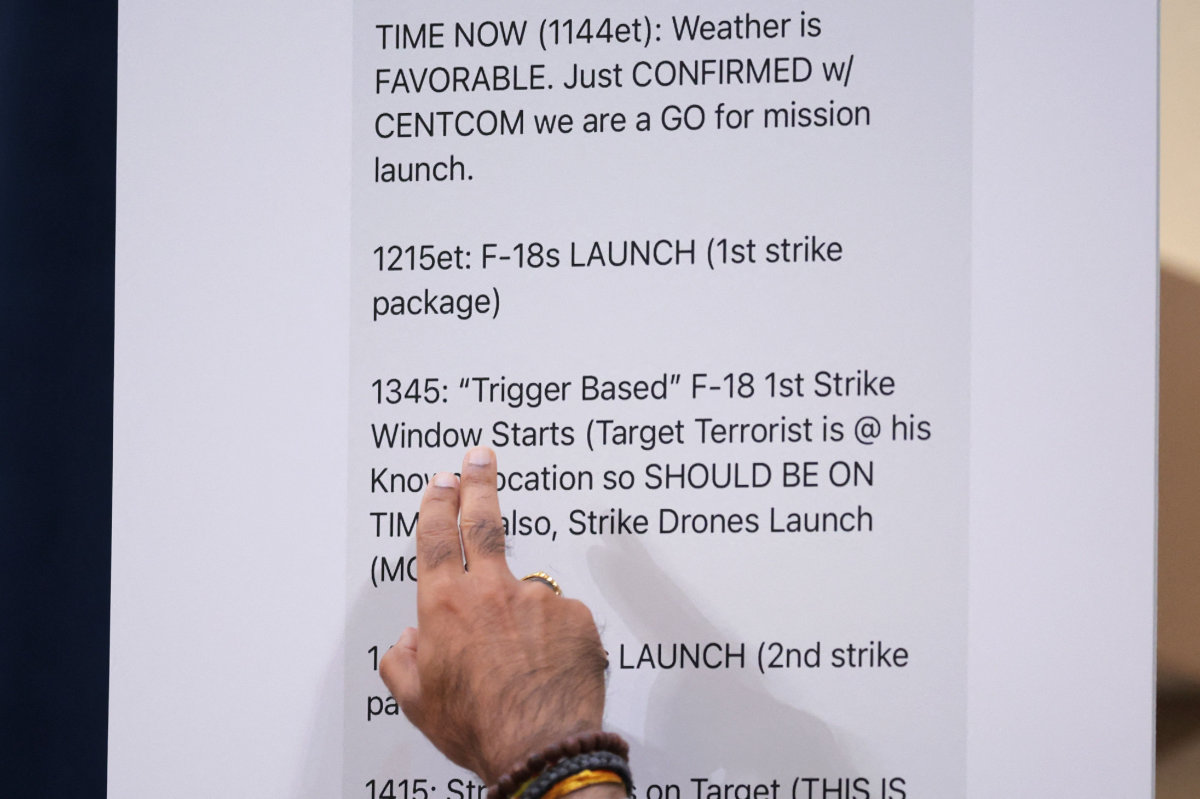WASHINGTON: Michael Gregoire marched along a downtown sidewalk in the tense days before the midterm elections, waving a hand-painted sign at passing traffic: “DEFEAT REPUBLICANS 2018.”
“The survival of the country is going to depend on this election,” he said as another man stopped for a moment to argue. The strangers faced each other from opposite edges of the great American divide, Democrat versus Republican, both convinced the election is among the most consequential in their lifetimes and that they must save the nation from the other side.
“I’m voting for Donald Trump,” Stuart Kanter said. “He’s not on the ticket. But, in a way, actually he is.”
President Donald Trump looms large over Tuesday’s election, which is expected to draw historic numbers to the polls and will determine which party controls Congress. For Gregoire and Kanter, and for voters across the country, the election represents something far greater than whatever Senate and House races appear on their ballots. It is a competition for the soul of America — a referendum on Trump and the venomous political culture that many blame for gridlock in Congress and a recent spate of hate crimes and politically motivated attacks.
Less than two weeks ago in this city, a white man gunned down two African-American shoppers at a grocery store in what police described as a racially motivated attack. Days later, an avid Trump supporter was arrested for mailing pipe bombs to prominent critics of the president, all of whom Trump routinely derides as “evil” and “un-American.” The next day, another gunman opened fire in a synagogue in Pittsburgh, massacring 11 worshippers and telling police “all these Jews need to die.”
Don Albrecht, a 75-year-old accountant and Republican who voted for Trump in 2016, lives blocks away from the Louisville grocery store where two people died. He’d pulled into the parking lot minutes after the gunfire erupted, saw the police cars and shaken employees, and felt like the country’s poisonous political climate had landed in his backyard. He wishes he could take back his vote for Trump.
“He has diarrhea of the mouth and diarrhea of the brain. He’s just so irresponsible,” said Albrecht, who worries Trump’s embrace of the far-right is remaking his party. “I don’t think the American public is going to put up with it. I think there’s going to be a big backlash against Republicans because of this divisiveness.”
He’s undecided going into Election Day. He can’t remember ever voting for a Democrat but said he might this time in protest.
Other Trump voters remain staunchly behind him, and plan to choose Republican candidates to help him make good on his pledges, including vows to implement more hard-line immigration policies.
“I want to see the wall go up,” said Joe Spirko, 57, as he peddled Trump flags outside of one of the president’s rallies in Florida last week. “Since Trump come along, I feel a lot better.”
Trump has stepped up his rhetoric on immigration ahead of the elections, focusing on a caravan of Central American migrants heading toward the US.
US midterm vote likely to draw historic numbers to the polls
US midterm vote likely to draw historic numbers to the polls

- Trump has stepped up his rhetoric on immigration ahead of the elections, focusing on a caravan of Central American migrants heading toward the US
Strong earthquake strikes central Myanmar, panic in Bangkok

There was no immediate word from Myanmar on damage after the quake, which the United States Geological Survey (USGS) said had a 7.7 magnitude and was at a depth of 10 km.
The epicenter was about 17.2 km from the city of Mandalay, which has a population about 1.2 million, according to USGS.
Witnesses in Bangkok said people ran out onto the streets in panic and water splashed out of swimming pools.
US Vice President Vance to visit Greenland, the island Trump wants to control

- Russia is winner in this dispute between NATO allies -analyst
- Original plan had triggered spat with Greenland, Denmark
NUUK: US Vice President JD Vance will visit Greenland on Friday at a time when President Donald Trump is renewing his insistence that Washington should take control of the semi-autonomous Danish territory.
In a scaled-back version of a trip plan that had angered authorities in both Greenland and Denmark, Vance was expected to fly to the US military base at Pituffik in the north of the Arctic island.
Under the terms of a 1951 agreement, the US is entitled to visit its base whenever it wants, as long as it notifies Greenland and Copenhagen.
The initial plan had been for Vance’s wife, Usha, to visit a popular dog-sled race together with national security adviser Mike Waltz, even though they were not invited by authorities in either Greenland or Denmark.
Waltz, who has faced pressure over Trump administration officials’ discussion of sensitive Houthi attack plans on the Signal messaging app, will still be on the Greenland trip, according to a White House source.
Greenland’s acting Prime Minister Mute Egede called the visit a provocation as the country has not yet formed a new government after a March 11 election.
Public broadcaster KNR reported on Thursday, without identifying its sources, that a pro-business party that emerged as the winner of the election will present a broad coalition on Friday.
Danish Prime Minister Mette Frederiksen called the US visit “unacceptable” although Foreign Minister Lars Lokke Rasmussen welcomed news of the revised visit as a positive, de-escalating step.
By changing the trip, the Trump administration is seeking to refocus the discussion on the topics it is interested in: the US presence on Greenland, military capabilities available, and the wider security of the Arctic, said Catherine Sendak, head of the Transatlantic Defense and Security program at the Center for European Policy Analysis, a Washington-based think tank.
“A change of course was needed,” Sendak told Reuters. “It is positive, given the very public back and forth between the Danish and Greenland governments and the Trump administration about the intent of the initial visit.”
Still, Trump reiterated his desire to take over Greenland, saying the US needs the strategically located island for national and international security.
“So, I think we’ll go as far as we have to go. We need Greenland and the world needs us to have Greenland, including Denmark,” he said on Wednesday.
Danish Defense Minister Troels Lund Poulsen condemned what he called Trump’s escalated rhetoric.
Who benefits from dispute?
The question now is how far Trump is willing to push his idea of taking over the island, said Andreas Oesthagen, a senior researcher on Arctic politics and security at the Oslo-based Fridtjof Nansen Institute.
“It is still unlikely that the United States will use military means to try to get full control over Greenland,” he told Reuters.
That would break with many fundamental principles and rules that the US has benefited from and has been a pillar for, he said.
“But it is unfortunately likely that President Trump and Vice President Vance will continue to use other means of pressure, such as ambiguous statements, semi-official visits to Greenland, and economic instruments,” he added.
“And the real winner in this unnecessary drama is Russia, who gets exactly what they want: discord in the transatlantic relationship.”
Tom Dans, a former member of the US Arctic Research Commission during Trump’s first presidency, said Vance’s visit would help the Trump administration understand where it can collaborate further with Greenland.
“They’re trying to put the picture together for the future and understand where the best intersections are going to be for US policy and investments to help Greenland,” Dans, a businessman, told Reuters.
Myanmar rebels disrupt China rare earth trade, sparking regional scramble

- Ethnic army controls area accounting for nearly half of global heavy rare earths production
- Rebels seek leverage against Beijing, which invested heavily in rare earths and supports Myanmar’s junta
BANGKOK: When armed rebels seized northern Myanmar’s rare-earths mining belt in October, they dealt a blow to the country’s embattled military junta — and wrested control of a key global resource.
By capturing sites that produce roughly half of the world’s heavy rare earths, the Kachin Independence Army (KIA) rebels have been able to throttle the supply of minerals used in wind turbines and electric vehicles, sending prices of one key element skyward.
The KIA is seeking leverage against neighboring China, which supports the junta and has invested heavily in rare earths mining in Myanmar’s Kachin state, according to two people familiar with the matter.
Chinese imports of rare earth oxides and compounds from Myanmar dropped to 311 metric tons in February, down 89 percent compared to the year-ago period, according to Chinese customs data that hasn’t been previously reported. Most of the fall came after October.
Reuters spoke to nine people with knowledge of Myanmar’s rare earths industry and its four-year civil war about turmoil in the mining belt.
One of them described the move by the KIA, which is part of a patchwork of armed groups fighting military rule, as an attempt to drive a wedge between the junta and China.
“They want to use rare earth reserves as a leverage in their negotiation with China,” said Dan Seng Lawn, executive director of the non-profit Kachinland Research Center, which studies Kachin socio-political issues.

Three of the people also detailed previously unreported interest in the sector by India, China’s regional rival, which they said in late 2024 sent officials from a state-owned rare earths mining and refining firm to Kachin.
The KIA is one of the largest and oldest ethnic militias in Myanmar. It fights for the autonomy of the Kachin minority, a mostly Christian group who have long held grievances against the Bamar Buddhist majority.
The group has imposed a hefty tax on the mostly Chinese-operated rare-earth miners working around Panwa and Chipwe towns in Kachin, according Dan Seng Lawn, whose institute is based in the state, and a Chinese mining analyst. China has been one of the staunchest international backers of Myanmar’s military since it deposed a civilian-led government in 2021 and ignited a bloody civil war. Beijing continues to see the junta as a guarantor of stability along its frontier, though the military has been ejected from most of the borderlands since a major rebel offensive in 2023.
A spokesperson for China’s Foreign Ministry said the department was not aware of the specifics of the situation in the mining belt but it continues to “actively promote peace talks and provide all possible support and assistance for the peace process in northern Myanmar.”
India’s external affairs ministry, the KIA and a junta spokesperson did not return requests for comment. Bawn Myang Co. Ltd, which the US government previously identified as an operator of mines in the area, couldn’t be reached.
PRICE SPIKE
Chinese spot prices of terbium oxide <SMM-REO-TXO>, whose supply is concentrated in Kachin, jumped 21.9 percent to 6,550 yuan per kg between late September and March 24, data from Shanghai Metals Market show. Prices of dysprosium oxide <SMM-REO-DXO>, which is also largely mined in Kachin but was in lower demand over the last six months, eased 3.2 percent to 1,665 yuan per kg during the same period. Most rare earths from Kachin are processed in China, so a protracted stalemate would have global implications.
“A prolonged shutdown would likely lead to higher, potentially more volatile rare earth prices in China, and a reshaping of market dynamics in the near term,” research firm Adamas Intelligence said in a February note.
EXPORT PLUNGE
Chinese miners started building up major operations in Kachin in the 2010s, after Beijing tightened regulations on domestic mines.
Kachin’s often unregulated mines steadily expanded after the 2021 coup with the tacit approval of the junta, according to the U.K-.based Global Witness non-profit.
But the growth came at a heavy cost, ravaging the environment and leaving Kachin’s hills pock-marked with leeching pools, according to witness accounts and satellite imagery. Since the KIA’s takeover, a 20 percent tax imposed by the rebels has made it effectively impossible for local operators to run profitable mines.
The KIA wants China to stop pushing it to set down arms against the junta and to recognize the rebels’ de facto control of the border, said Dan Seng Lawn, adding that the parties had met at least twice in recent months.
The KIA has full control of the border in areas where it operates and anti-junta groups rule most of the rest of Myanmar’s frontier with China. Beijing appeared reluctant to accept the KIA’s demands, though it risked its monopoly on Myanmar’s rare earth reserves if it doesn’t position itself pragmatically, Dan Seng Lawn said.
Reopening the minerals sector would be a major financial lifeline to the rebels: Myanmar’s heavy rare earths trade stood at around $1.4 billion in 2023, according to Global Witness. The KIA has told miners in Kachin it will now allow shipments of existing rare earth inventories to China, Reuters reported Thursday.
But to resume operations at full capacity, the KIA needs an agreement with China, home to thousands of workers with the know-how, said Singapore-based rare-earths expert Thomas Kruemmer.
“Without them, this won’t work, full stop,” he said.
India alternative?
Amid the ongoing tussle, India has attempted to deepen its influence in Kachin, with which it also shares a border, according to Dan Seng Lawn and two people familiar with Indian official thinking.
India’s state-run mining and refining firm IREL in December sent a team to Kachin to study resources there, according to one of the Indian sources, who spoke on condition of anonymity due to the sensitivity of the matter.
Indian authorities have reservations about operating in an area with armed non-state actors, but the Kachin desire to diversify away from China and New Delhi’s need for resources have pushed the two parties to talk, the Indian source said.
IREL did not return requests for comment.
An Indian delegation that included IREL also held an online meeting with the Kachins in December to discuss their interest in reopening the rare-earths sector, said Dan Seng Lawn, who attended the discussion.
They were willing to pay higher prices than China, he said.
Any India deal faces multiple obstacles, said Kruemmer and Dan Seng Lawn.
There is only skeletal infrastructure along the mountainous and sparsely populated Kachin-India frontier, making it challenging for commodities to be moved from Myanmar to the neighboring northeastern states of India. Those states are also far removed from India’s manufacturing belts in the south and west.
India also doesn’t have the ability to commercially process the heavy rare earths and transform them into magnets used by industry, according to Kruemmer and the Indian source. Some 90 percent of the world’s rare earths magnets are produced in China, which has brought the sector under tighter state control, followed by Japan.
Nevertheless, if Beijing does not recognize the “changing power dynamics,” Dan Seng Lawn said, the KIA “will have to open alternative options.”
US defense secretary reaffirms ‘ironclad’ commitment to the Philippines amid China threat

- “Deterrence is necessary around the world, but specifically in this region ... considering the threats from the communist Chinese,” Hegseth said
- His Manila trip, aimed at bolstering ties in the Asia-Pacific region, will be followed by trips to Tokyo and World War II battleground Iwo Jima
MANILA: US Defense Secretary Pete Hegseth reaffirmed the United States’ ironclad commitment to the Mutual Defense Treaty with the Philippines during his meeting with Philippine President Ferdinand Marcos Jr. on Friday.
Hegseth, who is in the Philippines as part of a trip to Asia, emphasized the strong alliance, friendship, and cooperation between the two nations.
“Deterrence is necessary around the world, but specifically in this region, in your country, considering the threats from the communist Chinese,” Hegseth said.
Hegseth’s Manila visit, to be followed by trips to Tokyo and World War II battleground Iwo Jima, follows months of confrontations between Philippine and Chinese vessels in the disputed South China Sea.
Beijing claims almost the entirety of the crucial waterway, despite an international ruling that its assertion has no merit.
“Friends need to stand shoulder to shoulder to deter conflict to ensure that there’s free navigation, whether you call it the South China Sea or the West Philippine Sea,” Hegseth said.
“Peace through strength is a very real thing,” he added.
The trip is aimed at bolstering ties in the Asia-Pacific region as tensions are rising with Beijing.
Hegseth is expected to meet his Philippine counterpart Gilberto Teodoro later Friday.
In response to China’s growing influence, the US has been strengthening alliances with countries in the Asia-Pacific region, including the Philippines.
Manila and Washington have deepened their defense cooperation since Marcos took office in 2022 and began pushing back on Beijing’s sweeping South China Sea claims.
In recent years, top US officials have warned that an “armed attack” against the Philippines in the waterway would invoke the two countries’ mutual defense treaty.
The two countries have expanded the sharing of military intelligence and boosted to nine the number of bases US troops have access to on the archipelago.
Given the Philippines’ proximity to Taiwan and its surrounding waters, Manila’s cooperation would be crucial in the event of a conflict with China.
Hegseth’s visit overlaps with bilateral military exercises that will expand next month to include the countries’ navies and air forces.
US defense chief texted start time of planned killing of Yemeni militant

- Democrats want Trump’s national security team fired over leaks
- But Trump downplays leak, calling it a “witch hunt” and defending Hegseth
WASHINGTON: Defense Secretary Pete Hegseth texted about plans to kill a Houthi militant leader in Yemen two hours before a military operation meant to be shrouded in secrecy, according to screenshots of a chat released by The Atlantic on Wednesday.
The revelation that highly sensitive attack plans were shared on a commercial messaging app, possibly on personal cellphones, has triggered outrage in Washington and calls from Democrats that members of Trump’s national security team be fired over the leaks.
Republican President Donald Trump’s administration has sought to contain the fallout from the revelation that the March 15 chat included The Atlantic’s editor-in-chief Jeffrey Goldberg on the encrypted messaging app Signal.
Hegseth has repeatedly denied texting war plans, and Trump and his top advisers are saying no classified information was shared, bewildering Democrats and former US officials, who regard timing and targeting details as some of the most closely held material ahead of a US military campaign.
“I think that it’s by the awesome grace of God that we are not mourning dead pilots right now,” Democrat Jim Himes of Connecticut said at a hearing of the House of Representatives Intelligence Committee.
Republican Senator Roger Wicker, who leads the Pentagon’s oversight committee in the Senate, joined calls for an independent probe and said the texts appeared so sensitive “I would have wanted it classified.”

If Houthi leaders knew a strike was coming, they might have been able to flee, possibly to crowded areas where targeting is more difficult and the number of potential civilian casualties might be deemed too high to proceed.
The chat did not appear to include any names or precise locations of Houthi militants being targeted or to disclose information that could have been used to target US troops carrying out the operation.
Pentagon officials aware of the planning believed that information Hegseth texted was classified at the time, one US official told Reuters, speaking on condition of anonymity, raising questions over whether, when and how Hegseth’s text messages may have been declassified.
It has also renewed scrutiny of Hegseth, who only narrowly won Senate confirmation after a bruising review that raised serious questions about his experience, temperament and views about women in combat.
The White House played down the idea that Hegseth or others would lose their jobs, saying Trump retained confidence in them.
Trump also played down the Yemen leak, calling it a “witch hunt” and defending Hegseth.
“Hegseth is doing a great job,” Trump said.
Goldberg, who had initially declined to publish the chat details, did so on Wednesday. The Atlantic magazine did not immediately respond to a request for comment on the release of the additional messages.
‘Team update’
Hegseth’s text started with the title “TEAM UPDATE” and included these details, according to The Atlantic:
“TIME NOW (1144et): Weather is FAVORABLE. Just CONFIRMED w/CENTCOM we are a GO for mission launch“
“1215et: F-18s LAUNCH (1st strike package)”
“1345: ‘Trigger Based’ F-18 1st Strike Window Starts (Target Terrorist is @ his Known Location so SHOULD BE ON TIME – also, Strike Drones Launch (MQ-9s)”
“1410: More F-18s LAUNCH (2nd strike package)”
“1415: Strike Drones on Target (THIS IS WHEN THE FIRST BOMBS WILL DEFINITELY DROP, pending earlier ‘Trigger Based’ targets)”
“1536 F-18 2nd Strike Starts – also, first sea-based Tomahawks launched.”
“MORE TO FOLLOW (per timeline)”
“We are currently clean on OPSEC”
“Godspeed to our Warriors.”

Hours later, national security adviser Mike Waltz confirmed to the group the killing of the Houthis’ top missile expert.
“We had positive ID of him walking into his girlfriend’s building and it’s now collapsed,” Waltz wrote, disclosing that the US was carrying out surveillance operations.
Reuters could not immediately establish what kind of building was brought down in the US military strike, how many occupants were inside, and how the detail squares with Pentagon statements there were no known civilian casualties.
Hegseth has declined to answer questions about whether he declassified the information on the Signal chat, perhaps retroactively. In Hawaii on Wednesday, he played down the controversy, telling reporters the texts contained “no locations, no routes, no flight paths, no sources, no methods.”
In Jamaica, US Secretary of State Marco Rubio, who was part of the chat group, acknowledged to reporters that someone “made a big mistake” by adding a journalist to the chat. But he also dismissed concerns about any impact on the operations.
Senior US national security officials have classified systems that are meant to be used to communicate secret materials.
But CIA Director John Ratcliffe testified on Tuesday at a Senate hearing that Waltz set up the Signal chat for unclassified coordination and that teams would be “provided with information further on the high side for high-side communication.”
Waltz has said he took full responsibility for the breach as he had created the Signal group. But on Wednesday, Waltz also played down the disclosure, saying on X: “No locations. No sources & methods. NO WAR PLANS. Foreign partners had already been notified that strikes were imminent.”
At a hearing on Wednesday, Director of National Intelligence Tulsi Gabbard said Hegseth would be the one to determine what defense information was classified.
“Ultimately, the secretary of defense (holds) the authority to classify or de-classify.” Gabbard said, addressing the House Intelligence Committee.
The US military has so far declined to publicly offer even basic details about the offensive in Yemen, including how many strikes have been carried out, what senior leaders have been targeted or killed and even whether the operation has a name.

















